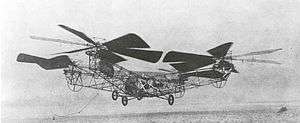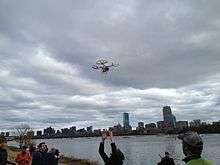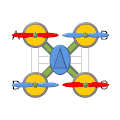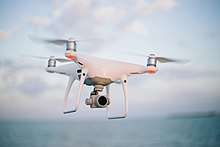Quadcopter
A quadcopter or quadrotor[1] is a type of helicopter with four rotors.[2]
Quadcopters generally have two rotors spinning clockwise (CW) and two counterclockwise (CCW). Flight control is provided by independent variation of the speed and hence lift and torque of each rotor. Pitch and roll are controlled by varying the net centre of thrust, with yay controlled by varying the net torque.[3]
Unlike conventional helicopters, quadrotors do not usually have cyclic pitch control, in which the angle of the blades varies dynamically as they turn around the rotor hub. In the early days of flight, quadcopters (then referred to either as 'quadrotors' or simply as 'helicopters') were seen as a possible solution to some of the persistent problems in vertical flight. Torque-induced control issues (as well as efficiency issues originating from the tail rotor, which generates no useful lift) can be eliminated by counter-rotation, and the relatively short blades are much easier to construct. A number of manned designs appeared in the 1920s and 1930s. These vehicles were among the first successful heavier-than-air vertical take off and landing (VTOL) vehicles.[4] However, early prototypes suffered from poor performance,[4] and latter prototypes required too much pilot work load, due to poor stability augmentation[5] and limited control authority.
Around 2005 to 2010, advances in electronics allowed the production of cheap lightweight flight controllers, accelerometers (IMU), global positioning system and cameras. This resulted in the quadcopter configuration becoming popular for small unmanned aerial vehicles. With their small size and maneuverability, these quadcopters can be flown indoors as well as outdoors.[1][6]
At a small size, quadcopters are cheaper and more durable than conventional helicopters due to their mechanical simplicity.[7] Their smaller blades are also advantageous because they possess less kinetic energy, reducing their ability to cause damage. For small-scale quadcopters, this makes the vehicles safer for close interaction. It is also possible to fit quadcopters with guards that enclose the rotors, further reducing the potential for damage.[2] However, as size increases, fixed propeller quadcopters develop disadvantages relative to conventional helicopters. Increasing blade size increases their momentum. This means that changes in blade speed take longer, which negatively impacts control. Helicopters do not experience this problem as increasing the size of the rotor disk does not significantly impact the ability to control blade pitch.
Due to their ease of construction and control, quadcopter aircraft are frequently used as amateur model aircraft projects.[8][9]
History
Early attempts
- Breguet-Richet Gyroplane (1907)
- A four-rotor helicopter designed by Louis Breguet. This was the first rotary wing aircraft to lift itself off the ground, although only in tethered flight at an altitude of a few feet. In 1908 it was reported as having flown 'several times', although details are sparse.[10]
- Oehmichen No.2 (1920)
- Etienne Oehmichen experimented with rotorcraft designs in the 1920s. Among the six designs he tried, his helicopter No.2 had four rotors and eight propellers, all driven by a single engine. The Oehmichen No.2 used a steel-tube frame, with two-bladed rotors at the ends of the four arms. The angle of these blades could be varied by warping. Five of the propellers, spinning in the horizontal plane, stabilized the machine laterally. Another propeller was mounted at the nose for steering. The remaining pair of propellers functioned as its forward propulsion. The aircraft exhibited a considerable degree of stability and increase in control-accuracy for its time, and made over a thousand test flights during the middle 1920s. By 1923 it was able to remain airborne for several minutes at a time, and on April 14, 1924 it established the first-ever FAI distance record for helicopters of 360 m (390 yd). It demonstrated the ability to complete a circular course[11] and later, it completed the first 1 kilometre (0.62 mi) closed-circuit flight by a rotorcraft.

- de Bothezat helicopter (1922)
- Dr. George de Bothezat and Ivan Jerome developed this aircraft, with six-bladed rotors at the end of an X-shaped structure. Two small propellers with variable pitch were used for thrust and yaw control. The vehicle used collective pitch control. Built by the US Air Service, it made its first flight in October 1922. About 100 flights were made by the end of 1923. The highest it ever reached was about 5 m (16 ft 5 in). Although demonstrating feasibility, it was underpowered, unresponsive, mechanically complex and susceptible to reliability problems. Pilot workload was too high during hover to attempt lateral motion.
- Convertawings Model A Quadrotor (1956)
- This unique helicopter was intended to be the prototype for a line of much larger civil and military quadrotor helicopters. The design featured two engines driving four rotors through a system of v belts. No tail rotor was needed and control was obtained by varying the thrust between rotors.[12] Flown successfully many times in the mid-1950s, this helicopter proved the quadrotor design and it was also the first four-rotor helicopter to demonstrate successful forward flight. Due to a lack of orders for commercial or military versions however, the project was terminated. Convertawings proposed a Model E that would have a maximum weight of 42,000 lb (19 t) with a payload of 10,900 lb (4.9 t) over 300 miles and at up to 173 mph (278 km/h). The Hanson Elastic Articulated (EA) bearingless rotor grew out of work done in the early 1960s at Lockheed California by Thomas F. Hanson, who had previously worked at Convertawings on the quadrotor's rotor design and control system.[13][14]

- Curtiss-Wright VZ-7 (1958)
- The Curtiss-Wright VZ-7 was a VTOL aircraft designed by Curtiss-Wright in competition for the US Army Transport and Research Command "flying jeep". The VZ-7 was controlled by changing the thrust of each of the four ducted fan rotors.
The Piasecki PA-97 was an extreme example where four helicopter fuselages were combined with a lighter-than-air blimp in the 1980s.
Recent developments
In the last few decades, small-scale unmanned aerial vehicles have been used for many applications. The need for aircraft with greater maneuverability and hovering ability has led to a rise in quadcopter research. The four-rotor design allows quadcopters to be relatively simple in design yet highly reliable and maneuverable. Research is continuing to increase the abilities of quadcopters by making advances in multi-craft communication, environment exploration, and maneuverability. If these developing qualities can be combined, quadcopters would be capable of advanced autonomous missions that are currently not possible with other vehicles.[15]
Some current programs include:
- The Bell Boeing Quad TiltRotor concept takes the fixed quadcopter concept further by combining it with the tilt rotor concept for a proposed C-130 sized military transport.


- AeroQuad and ArduCopter are open-source hardware and software projects based on Arduino for the DIY construction of quadcopters.[16][17]
- Nixie is a small camera-equipped drone that can be worn as a wrist band.[18][19][20]
- Airbus is developing a battery-powered quadcopter to act as an urban air taxi, at first with a pilot but potentially autonomous in the future.[21]
Several camera-drone projects have turned into high-profile commercial failures:
- Zano (drone) – a high-profile Kickstarter project to build a quadcopter-camera drone, Zano failed after delivering only a small fraction of their orders in a partially nonfunctional state.[22][23]
- Lily Camera – a startup attempting to make a quadcopter-camera drone, sued by the San Francisco District Attorney after they closed down without fulfilling any of their pre-orders.[24][25][26]
In July 2015, a video was posted on YouTube of an airborne quadcopter firing a pistol four times in a wooded area, sparking regulatory concerns.[27][28]
Applications

Research platform
Quadcopters are a useful tool for university researchers to test and evaluate new ideas in a number of different fields, including flight control theory, navigation, real time systems, and robotics. In recent years many universities have shown quadcopters performing increasingly complex aerial manoeuvres. Swarms of quadcopters can hover in mid-air,[29][30][31][32] fly in formations,[33][34][35][36][37] and autonomously perform complex flying routines such as flips, darting through hula hoops and organising themselves to fly through windows as a group.[38]
There are numerous advantages to using quadcopters as versatile test platforms. They are relatively cheap, available in a variety of sizes and their simple mechanical design means that they can be built and maintained by amateurs. Due to the multi-disciplinary nature of operating a quadcopter, academics from a number of fields need to work together in order to make significant improvements to the way quadcopters perform. Quadcopter projects are typically collaborations between computer science, electrical engineering and mechanical engineering specialists.[39]
Military and law enforcement
Quadcopter unmanned aerial vehicles are used for surveillance and reconnaissance by military and law enforcement agencies, as well as search and rescue missions in urban environments.[40] One such example is the Aeryon Scout, created by Canadian company Aeryon Labs,[41] which is a small UAV that can quietly hover in place and use a camera to observe people and objects on the ground. The company claims that the quadrotor played a key role in a drug raid in Central America by providing visual surveillance of a drug trafficker's compound deep in the jungle (Aeryon has declined to name the exact country and provide other specific details).[42]
The weaponization of drones is now a huge concern to the wider security industry, as is their use to disrupt airspace, as seen at Gatwick Airport in the UK in December 2018,[43] prompting the United Kingdom’s Civil Aviation Authority, via Parliament to make expedient changes to UK drone laws.[44]
After a recreational quadcopter (or "drone") crashed on the White House lawn early in the morning of January 26, 2015,[45] the Secret Service began a series of test flights of such equipment in order to fashion a security protocol against hostile quadcopters.[46]
During the Battle of Mosul it was reported that commercially available quadcopters and drones were being used by Islamic State of Iraq and the Levant (ISIL) as surveillance and weapons delivery platforms using improvised cradles to drop grenades and other explosives.[47] The ISIL drone facility became a target of Royal Air Force strike aircraft.[48]
Photography

The largest use of quadcopters in the USA has been in the field of aerial imagery. Quadcopter UAVs are suitable for this job because of their autonomous nature and huge cost savings.[15] Drones have also been used for light-painting photography.[49][50][51]
Journalism
In 2014 The Guardian reported that major media outlets have started to put serious effort into exploring the use of drones for reporting and verifying news on events that include floods, protests and wars.[52]
Some media outlets and newspapers are using drones to capture photography of celebrities.[53]
Drone-delivery
In December 2013, the Deutsche Post gathered international media attention with the project Parcelcopter, in which the company tested the shipment of medical products by drone delivery. Using a Microdrones md4-1000 quadrocopter, packages were flown from a pharmacy across the Rhine River. It was the first civilian package delivery via drones.[54][55]
Humanitarian operations
Quadcopters are being used for a wide variety of humanitarian applications from disaster relief to animal conservation. During Hurricane Harvey, many drone pilots with quadcopters at their disposal descended on the city of Houston, Texas to provide support to first responders.[56]
Art
Quadcopters have also been used in various art projects including but not limited to drone photography. At least one drone has demonstrated the feasibility of painting graffiti on a wall with spray paint.[57] They may be used in performance art with new degrees of positional control that allows for new uses of puppets, characters, lights and cameras.[58] They have also been used in light shows[59] including most prominently in the 5 February 2017 Super Bowl LI halftime show in which Lady Gaga, in a pre-recorded segment, was accompanied by a swarm of 300 LED-equipped Intel "Shooting Star" drones forming an American flag in the sky.[60][61][62][63]
Sport
Quadcopters are used all over the world for racing (also known as "drone racing") and freestyle events.[64] Racing and freestyle quadcopters are built for speed and agility. Racing and freestyle drones tend to be relatively small in size, with 250 mm between the propeller shafts and/or 5-6 inch props being the usually upper end of the size scale.[65]
There are at least three international drone racing organisations/promotions including the Drone Racing League[66], Multi GP.[67] And the Drone Championship League[68]
Law
In the United States
In the United States, the legality of the use of remotely controlled aircraft for commercial purposes has been the source of legal issues. Raphael Pirker, a professional photographer, was fined by the FAA in 2012 for "endangering people on the ground" (a regulatory infraction) after he used a Zephyr fixed-wing drone—a "five-pound Styrofoam model airplane"—to take aerial photos of the University of Virginia's campus in 2011.[69][70] In March 2014, a federal administrative law judge ruled in Pirker's favor, determining that his drone was a "model aircraft" and thus not subject to FAA regulations on other types of aircraft.[69] The FAA appealed to the National Transportation Safety Board; the NTSB appointed a new administrative law judge, who overturned the earlier finding and ruled that under the FAA's enabling act, the FAA had jurisdiction to regulate "any contrivance invented, used or designed to navigate, or fly in, the air," irrespective of whether it was unmanned or manned.[69] Pirker was fined $10,000, but in January 2015 settled the matter with the FAA, agreeing to pay a $1,100 fine without admitting guilt.[69] According to a report in Aviation Week, the matter "became a cause célèbre among the model aircraft and recreational and commercial small drone communities."[69]
In December 2014, the FAA released a video detailing many best practices for new drone pilots, including advisories such as keeping their machines below 400 feet and always within visual sight.[71]
As of March 2015, the United States created an interim policy for the legal use of unmanned aerial vehicles for commercial use where each operator can apply for an exemption filed under Section 333 with the FAA. As of August 2015 the FAA had granted over 1300 petitions to different use cases and industries.[72] Furthermore, FAA has started discussions in November 2015 to require all hobbyists to also register personal drones to FAA website.[73]
In December 2014, FAA started the registration process for all model aircraft weighing more than 0.55 pounds (≈ 250 grams) and less than 55 pounds (≈ 25 kilograms), including payloads such as all on-board cameras and other accessories. FAA's decision on the matter caused resistance from the hobbyist community at the time. In October 2015 the FAA issued rules legally requiring registration, starting January 2016, but on May 19, 2017, the United States Court of Appeals for the Washington D.C. circuit ruled that this violated the 2012 FAA Modernization and Reform Act, which states that the FAA “may not promulgate any rule or regulation regarding a model aircraft.”[74] The FAA continues to allow registration on a voluntary basis, as well as requiring it for commercial use, but states that it is not required if "flying under the Special Rule for Model Aircraft" (recreational hobby use).[75]
In addition to the registration requirement, FAA has also released various operational requirements as follows:[76]
- Flight only below 400 feet above ground.
- The operator must maintain visual contact with the aircraft at all times.
- Not fly near manned aircraft, especially near airports.
- Not fly over groups of people, stadiums or sporting events.
- Not fly near emergency response efforts, such as accident sites or forest fires.
On October 5, 2018, the FAA Reauthorization Act of 2018 passed congress and was sent for the president's signature. The bipartisan bill split the hobbyist community, with the Commercial Drone Alliance in favor of the new law, while the Academy of Model Aeronautics urged its members to oppose the bill.[77]
The major change in the new law is the repeal of Section 336. All sUAS owners, including quadcopters, will be required to register their aircraft and pass a general aeronautical knowledge test. In June 2019, the FAA announced new rules for recreational and non-commercial fliers. Recreational pilots would no longer be allowed to fly in controlled airspace by contacting air traffic control towers. This rule will be in effect until the LAANC system for hobbyists is rolled out in the summer of 2019.[78]
Flight dynamics
Each rotor produces both a thrust and torque about its center of rotation, as well as a drag force opposite to the vehicle's direction of flight. If all rotors are spinning at the same angular velocity, with rotors one and three rotating clockwise and rotors two and four counterclockwise, the net aerodynamic torque, and hence the angular acceleration about the yaw axis, is exactly zero, which means there is no need for a tail rotor as on conventional helicopters. Yaw is induced by mismatching the balance in aerodynamic torques (i.e., by offsetting the cumulative thrust commands between the counter-rotating blade pairs).[79][80]
 Schematic of reaction torques on each motor of a quadcopter aircraft, due to spinning rotors. Rotors 1 and 3 spin in one direction, while rotors 2 and 4 spin in the opposite direction, yielding opposing torques for control.
Schematic of reaction torques on each motor of a quadcopter aircraft, due to spinning rotors. Rotors 1 and 3 spin in one direction, while rotors 2 and 4 spin in the opposite direction, yielding opposing torques for control. The red propellers are moving clockwise while the blue propellers are moving counterclockwise.
The red propellers are moving clockwise while the blue propellers are moving counterclockwise. A quadrotor hovers or adjusts its altitude by applying equal thrust to all four rotors.
A quadrotor hovers or adjusts its altitude by applying equal thrust to all four rotors. A quadrotor adjusts its yaw by applying more thrust to rotors rotating in one direction.
A quadrotor adjusts its yaw by applying more thrust to rotors rotating in one direction. A quadrotor adjusts its pitch or roll by applying more thrust to one rotor and less thrust to its diametrically opposite rotor.
A quadrotor adjusts its pitch or roll by applying more thrust to one rotor and less thrust to its diametrically opposite rotor.
Coaxial configuration
In order to allow more power and stability at reduced weight, a quadcopter, like any other multirotor can employ a coaxial rotor configuration. In this case, each arm has two motors running in opposite directions (one facing up and one facing down).[81]
Vortex ring state
All quadcopters are subject to normal rotorcraft aerodynamics, including vortex ring state.[82]
Mechanical structure
The main mechanical components needed for construction are the frame, propellers (either fixed-pitch or variable-pitch), and the electric motors. For best performance and simplest control algorithms, the motors and propellers should be placed equidistant.[83] Recently, carbon fiber composites have become popular due to their light weight and structural stiffness.
The electrical components needed to construct a working quadcopter are similar to those needed for a modern RC helicopter. They are the electronic speed control module, on-board computer or controller board, and battery (or fuel cell[84]). Typically, a hand-held transmitter is also used to allow for human input.[85]
Autonomous flight
Quadcopters and other multicopters often can fly autonomously. Many modern flight controllers use software that allows the user to mark "way-points" on a map, to which the quadcopter will fly and perform tasks, such as landing or gaining altitude.[86] The PX4 autopilot system, an open-source software/hardware combination in development since 2009, has since been adopted by both hobbyists and drone manufacturing companies alike to give their quadcopter projects flight-control capabilities. Other flight applications include crowd control between several quadcopters where visual data from the device is used to predict where the crowd will move next and in turn direct the quadcopter to the next corresponding waypoint.[87]
Endurance
Electric quadcopters have shorter endurance when compared to similarly sized electric helicopters because of the smaller "disk area" of the rotor blades. The longest flight time achieved by a battery-powered quadcopter was 2 hours, 31 minutes and 30 seconds. The record was set by Ferdinand Kickinger of Germany in 2016.[88] In setting the record, Kickinger used low-discharge rate, high capacity Lithium Ion batteries and stripped the airframe of non-essential weight to reduce power draw and extend endurance. However, the lack of features and the use of a low discharge battery make the vehicle unusable as a commercial product.[89]
Alternative power sources like hydrogen fuel cells and hybrid gas-electric generators have been used to dramatically extend the endurance of quadcopters and multirotors in general because of the increased energy density of both hydrogen and gasoline, respectively.[90]
See also
References
- Hoffmann, G.M.; Rajnarayan, D.G.; Waslander, S.L.; Dostal, D.; Jang, J.S.; Tomlin, C.J. (November 2004). "The Stanford Testbed of Autonomous Rotorcraft for Multi Agent Control (STARMAC)". In the Proceedings of the 23rd Digital Avionics System Conference. Salt Lake City, UT. pp. 12.E.4/1–10. doi:10.1109/DASC.2004.1390847.
- Hoffman, G.; Huang, H.; Waslander, S.L.; Tomlin, C.J. (20–23 August 2007). "Quadrotor Helicopter Flight Dynamics and Control: Theory and Experiment" (PDF). In the Conference of the American Institute of Aeronautics and Astronautics. Hilton Head, South Carolina. Archived from the original (PDF) on 13 August 2010.
- Stafford, Jesse (Spring 2014). "How a Quadcopter works | Clay Allen". University of Alaska, Fairbanks. Retrieved 2015-01-20.
- Leishman, J.G. (2000). Principles of Helicopter Aerodynamics. New York, NY: Cambridge University Press. ISBN 9780521858601.
- Anderson, S.B. (1997). "Historical Overview of V/STOL Aircraft Technology". NASA Technical Memorandum 81280.
- Büchi, Roland (2011). Fascination Quadrocopter. ISBN 978-3-8423-6731-9.
- Pounds, P.; Mahony, R.; Corke, P. (December 2006). "Modelling and Control of a Quad-Rotor Robot" (PDF). In the Proceedings of the Australasian Conference on Robotics and Automation. Auckland, New Zealand.
- "How-To: Quadrocopter based on Arduino". MAKE. Archived from the original on 11 December 2011. Retrieved 29 December 2014.
- "FrontPage - UAVP-NG - The Open Source Next Generation Multicopter". Retrieved 29 December 2014.
- Young, Warren R. (1982). The Helicopters. The Epic of Flight. Chicago: Time-Life Books. p. 28. ISBN 978-0-8094-3350-6.
- "A Successful French Helicopter" Flight 24 January 1924 p47
- "1956 - 1564 - Flight Archive". flightglobal.com. Retrieved 13 March 2015.
- "Patent US3261407 - Helicopter rotor system". google.com. Retrieved 13 March 2015.
- Inan, Esin; Kiris, Ahmet (2007-01-20). The Seventh International Conference on Vibration Problems ICOVP 2005. ISBN 9781402054013. Retrieved 13 March 2015.
- "Illumin - The Quadrotor's Coming of Age". Retrieved 29 December 2014.
- Davies, Chris (13 January 2010). "DIY Quadrocopters: Quaduino NG and AeroQuad [Videos]". SlashGear. Retrieved 4 February 2012.
- "ArduCopter 3D Robotics Quadcopter". Retrieved May 24, 2012.
- "Official Nixie website". Nixie. Retrieved 8 October 2014.
- Kumparak, Greg (28 September 2014). "A wearable drone that launches off your wrist to take your selfie". TechCrunch. Retrieved 11 October 2014.
- Monckton, Paul (29 September 2014). "Nixie, the wearable selfie drone". Forbes: Life. Retrieved 8 October 2014.
- "Airbus on track to fly its electric aerial taxi in 2018".
- "Best laid plans of mobs and men: The 5 biggest crowdfunding failures of all time". digitaltrends.com. 28 July 2016. Retrieved 28 January 2017.
- Knibbs, Kate. "The 9 Most Disgraceful Crowdfunding Failures of 2015". gizmodo.com. Retrieved 28 January 2017.
- "Drone company Lily shuts down owing $34m". BBC News. 12 January 2017.
- "Much-hyped Lily Camera Drone going out of business". cnet.com. Retrieved 28 January 2017.
- Mac, Ryan. "How An Allegedly Fake Video Killed A Much-Hyped Drone Startup". forbes.com. Retrieved 28 January 2017.
- Samuel Gibbs (2015-07-16). "Drone firing handgun appears in video". the Guardian. Retrieved 20 July 2015.
- "A drone firing a gun: so this is what all the regulation is about". thestack.com. Retrieved 20 July 2015.
- Saska, M.; Vakula, J.; Preucil, L. Swarms of Micro Aerial Vehicles Stabilized Under a Visual Relative Localization. In ICRA2014: Proceedings of 2014 IEEE International Conference on Robotics and Automation. 2014.
- Saska, M. MAV-swarms: unmanned aerial vehicles stabilized along a given path using onboard relative localization. In Proceedings of 2015 International Conference on Unmanned Aircraft Systems (ICUAS). 2015
- Bennet, D. J.; McInnes, C. R. Verifiable control of a swarm of unmanned aerial vehicles. Journal of Aerospace Engineering, vol. 223, no. 7, pp. 939–953, 2009.
- Saska, M.; Chudoba, J.; Preucil, L.; Thomas, J.; Loianno, G.; Tresnak, A.; Vonasek, V.; Kumar, V. Autonomous Deployment of Swarms of Micro-Aerial Vehicles in Cooperative Surveillance. In Proceedings of 2014 International Conference on Unmanned Aircraft Systems (ICUAS). 2014.
- Saska, M.; Kasl, Z.; Preucil, L. Motion Planning and Control of Formations of Micro Aerial Vehicles. In Proceedings of the 19th World Congress of the International Federation of Automatic Control. 2014.
- Barnes, L.; Garcia, R.; Fields, M.; Valavanis, K. Swarm formation control utilizing ground and aerial unmanned systems Archived 2017-08-13 at the Wayback Machine, in IEEE/RSJ International Conference on Intelligent Robots and Systems. 2008.
- Saska, M.; Vonasek, V.; Krajnik, T.; Preucil, L. (October 7–12, 2012). "Coordination and navigation of heterogeneous UAVs-UGVs teams localized by a hawk-eye approach". In Proceedings of 2012 IEEE/RSJ International Conference on Intelligent Robots and Systems. doi:10.1109/IROS.2012.6385517.CS1 maint: uses authors parameter (link)
- Saska, Martin; Vonásek, Vojtěch; Krajník, Tomáš; Přeučil, Libor (September 2014). "Coordination and navigation of heterogeneous MAV–UGV formations localized by a 'hawk-eye'-like approach under a model predictive control scheme" (PDF). The International Journal of Robotics Research. 33 (10): 1393–1412. doi:10.1177/0278364914530482. ISSN 0278-3649.
- No, T.S.; Kim, Y.; Tahk, M.J.; Jeon, G.E. (September 2011). "Cascade-type guidance law design for multiple-UAV formation keeping". Aerospace Science and Technology. 15 (6): 431–439. doi:10.1016/j.ast.2010.08.011. ISSN 1270-9638.CS1 maint: uses authors parameter (link)
- "UPenn's GRASP lab unleashes a swarm of Nano Quadrotors". 2012-02-02. Retrieved 29 December 2014.
- "Semi-Autonomous Gesture Controlled UAV Transportation System" (PDF). Retrieved 18 October 2015.
- "Armed Quadrotors Are Coming". Popular Mechanics. 2012-07-16. Retrieved 29 December 2014.
- "Aeryon Labs Inc". Retrieved 29 December 2014.
- "Aeryon Scout Quadrotor Spies On Bad Guys From Above". Retrieved 29 December 2014.
- Rowlatt, Justin (2019-04-14). "Gatwick drone attack possible inside job, say police". BBC News. Retrieved 9 July 2019.
- "Drone no-fly zone to be widened after Gatwick chaos". BBC News. 2019-02-20. Retrieved 9 July 2019.
- Los Angeles Times (26 January 2015). "Drone crashes at White House; its operator contacts Secret Service". latimes.com. Retrieved 13 March 2015.
- Secret Service Testing Drones In Bid To Defend White House, Associated Press, March 10, 2015
- Eshel, Tamir (12 October 2016). "Weaponized Mini-Drones Entering the Fight". Defense Update. Retrieved 25 February 2017.
- Eshel, Tamir (17 January 2017). "RAF Strikes Daesh Drone Facility in Mosul". Defense Update. Retrieved 25 February 2017.
- "Long-Exposure Photos Capture Light Art with Drones in New Mexico". The Creators Project. February 2017. Retrieved 11 February 2017.
- "UAS maker creates world's first drone light paintings with a holiday theme". Digital Trends. 18 December 2015. Retrieved 11 February 2017.
- "On Falcon, On Phantom! Drones Draw Holiday 'Light Paintings' in the Sky". NBC News. Retrieved 11 February 2017.
- Haddou, Leila (12 February 2014). "Journalism gets into the act as drones capture floods, protests and wars". The Guardian. Retrieved 11 February 2017.
- "Paparazzi Agency -- We've Used Drones For A Long Time". www.tmz.com. Retrieved 29 December 2014.
- "See DHL's futuristic "parcelcopter" drone deliver packages". Retrieved 18 June 2014.
- "A prototype "parcelcopter" of German postal and logistics group Deutsche Post DHL flies in Bonn". Archived from the original on 17 April 2015. Retrieved 18 June 2014.
- "Professional drone pilots join Harvey rescue effort". Fox News. 2017-08-31. Retrieved 2018-06-06.
- Posted by Tsuru Robotics on March 29, 2018 at 3:30am; Blog, View. "World's First Graffiti Drone (Part 1)". diydrones.com.
- McNicholas, Robin (19 December 2014). "Will 2015 be the year drones become art?". The Guardian. Retrieved 11 February 2017.
- "Drones As Works Of Art". Forbes. Retrieved 11 February 2017.
- "Drone expert explains how Lady Gaga's 300 Super Bowl halftime flyers worked". CBC News. Retrieved February 6, 2017.
- Barrett, Brian (2017-02-06). "All About Lady Gaga's Super Bowl Halftime Show Drones". Wired. Retrieved February 6, 2017.
- Perez, Chris (February 6, 2017). "This is what 300 drones flying in sync looks like". New York Post. Retrieved February 6, 2017.
- "Yes, those were drones at Lady Gaga's Super Bowl 51 halftime show". For The Win. February 6, 2017. Retrieved February 6, 2017.
- Victor, Daniel (14 September 2016). "Drone Racing Becomes ESPN's Newest Televised Sport". The New York Times. Retrieved 6 March 2017.
- Liang, Oscar (February 2018). How To Choose a Mini Quad Frame - The Basics and Evolution. oscarliang.com
- "The Drone Racing League - The Premier Drone Racing League". thedroneracingleague.com. Retrieved 6 March 2017.
- "About MultiGP - MultiGP".
- "How drone races work | DCL - The Drone Champions League". Drone Champions League.
- David Esler, FAA vs. Raphael Pirker, Aviation Week (December 28, 2015).
- David Feith, The Drone That Shot Down the Feds, Wall Street Journal (March 24, 2014).
- "The FAA explains how to 'stay off the naughty list' with your new drone". Retrieved 2014-12-22.
- "Commercial Drone Operators in the USA". 2015-09-15.
- "FAA Administrator Opens UAS Registration Meeting". www.faa.gov. Retrieved 2017-07-09.
- "FAA recreational drone registry struck down by federal appeals court". NBC News. Retrieved 2017-07-21.
- "sUAS Registration". registermyuas.faa.gov. Retrieved 2017-07-21.
- "FAA Small Unmanned Aircraft Registration Begins". www.faa.gov. Retrieved 2017-07-09.
- "FAA Reauthorization Act of 2018" (PDF).
- "Recreational Flyers & Modeler Community-Based Organizations". www.faa.gov. Retrieved 2019-06-24.
- "Quadrotor". Archived from the original on 27 December 2014. Retrieved 29 December 2014.
- Andrew Hobden. "Quadcopters: Yaw". hoverbear.org. Retrieved 3 April 2017.
- Hu, Jiaqi (November 2018). Tdrone, Open source coaxial drone. diydrones.com
- "Quadcopter "Wobble of Death": VRS Recovery and Avoidance". YouTube. Retrieved 21 September 2014.
- Uriah (2010-04-13). "Wyvern Quadrotor Helicopter". Retrieved 29 December 2014.
- "Hydrogen-powered drone will fly for hours at a time". Engadget.
- jjdream (6 September 2010). "Quadrotor". Instructables.com. Retrieved 29 December 2014.
- "arducopter - Arduino-based autopilot for mulirotor craft, from quadcopters to traditional helis - Google Project Hosting". Retrieved 2013-08-15.
- Khaleghi, Amirreza (2014). "A Comparative Study of Control Architectures in UAV/UGV - based Surveillance System" (PDF): 4. Cite journal requires
|journal=(help) - Ferdinand Kickinger (2016-04-30), 151min30s FPV with Copter, retrieved 2018-08-26
- SPK Drones. How Quadcopters Fly.
- McNabb, Miriam (February 2018). US Manufacturer Harris Aerial Launches New Hybrid Gas Electric Drone. Dronelife
External links
| Wikimedia Commons has media related to Quadrotors. |

